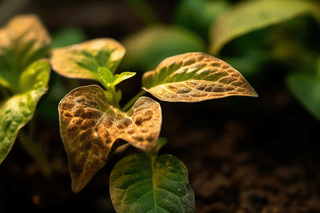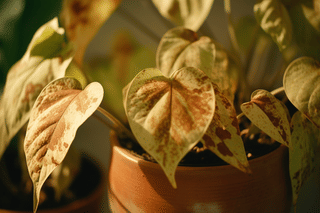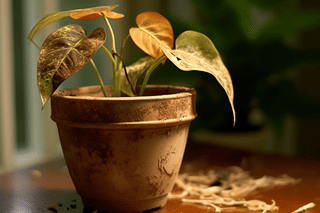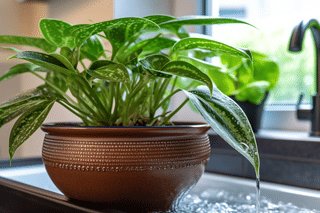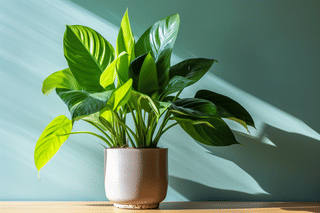How to avoid fertilizer burn in houseplants
In this comprehensive guide, you will learn the simple steps to prevent fertilizer burn in your beloved houseplants. Our easy-to-follow tips will help you keep your plants healthy and thriving, without the risk of damaging them with too much fertilizer. Say goodbye to wilted leaves and hello to lush, vibrant foliage with our plant care expertise.
Have ever wondered why your lush green houseplants suddenly start developing brown or yellow spots? Even the healthiest houseplants can get fertilizer burn. As a plant parent, it can sometimes be difficult to deal with this, especially when you're trying your best to give your houseplants the best care possible.
In this guide, we'll uncover everything you need to know about fertilizer burn, including what causes it, how to identify it, and most importantly, how to avoid it in your houseplants.
These are the topics we're going to look at:
Whether you've taken care of plants for years or you're just starting, this guide will give you the knowledge and confidence to keep your indoor plants healthy and happy. So, let's dive right in and see how we can help our plants!
What is fertilizer burn?
Fertilizer Burn is a term that scares many houseplant owners. But don't worry, it's not as bad as it sounds. Fertilizer burn is what happens when your plants get too much fertilizer. All plants need nutrients to grow, and fertilizer is an excellent source. But just like everything else in life, too much of a good thing isn't always good. Too much fertilizer can harm your plants, resulting in what's known as "fertilizer burn."
Common signs of fertilizer burn in houseplants
Every houseplant owner should know the common signs of fertilizer burn, and fortunately, recognizing it is quite simple. Here's what you need to look out for:
- Brown Leaf tips: This is usually the first sign. Leaf tips turn brown because they're getting too many nutrients which disrupts their water intake.
- Yellow or Brown Leaf Edges: Similar to brown leaf tips, the leaf edges might turn yellow or brown.
- Wilting or Drooping: Even well-watered plants can wilt or droop if they've experienced fertilizer burn.
- Slow Growth: If your plant is getting too much fertilizer, it might slow down its growth.
- White, Salt-like Substance on Soil Surface: Too much fertilizer can leave a white salt-like deposit on the soil surface.
These signs look very similar to a houseplant that's too dry. If you know you've properly watered your plant, then you might be dealing with a plant that has had too much fertilizer. Any combination of these signs may indicate a case of fertilizer burn. But don't panic, there are ways to solve this problem.
How to recognize too much fertilizer in houseplants
If you notice any of the symptoms mentioned above, your plant may have a case of fertilizer burn. But how can you be sure it's because of too much fertilizer?
Start by looking at your plant care routine. Have you recently increased the frequency or amount of fertilization? If yes, then the symptoms are likely due to over-fertilization.
Another good indicator is the plant's overall health. A healthy plant that suddenly shows signs of distress soon after fertilization is a clear sign that you've used too much.
Next, inspect the soil. If you notice a white, salt-like crust on the soil's surface, it means there's a high level of fertilizer salt in the soil, which is a sign of over-fertilization.
By being observant and understanding these signs, you'll be able to maintain the health of your houseplants and prevent cases of fertilizer burn in the future. Remember, when it comes to fertilizing, less is more. Now, let's have a look at how we can prevent fertilizer burn in the future.
How to prevent fertilizer burn in houseplants
Everyone loves a healthy and full houseplant, but taking care of plants might sometimes lead to unexpected issues, like fertilizer burn. Let's see how we can prevent fertilizer burn from happening on your plant in the first place.
Correct application of fertilizers in houseplants
Knowing how to correctly apply fertilizer can mean the difference between a healthy, thriving plant and one fighting fertilizer burn. Let's look at a few guidelines to follow when fertilizing your houseplants.
- Frequency: Don't overfeed your plants! Always follow the instructions on the label of your fertilizer. Every fertilizer is mixed differently and has different strengths. The fertilizer manufacturers have made it easy for you to use the right amount, so be sure to stick to their recommendations.
- Amount: When it comes to how much to use, less is more. Always dilute the fertilizer with water according to the instructions of the manufacturer. Some experts will tell you to use use the fertilizer at half-strength, but I disagree with this. The manufacturers know their product and it has gone through extensive testing for optimal results.
- Application: Apply the fertilizer to moist soil only as dry soil can't absorb nutrients as well, leading to burns.
Choose the right fertilizer for your houseplant
Just like humans, different plants have different nutrient needs. You wouldn't feed a cactus the same food you feed an orchid, right? You can help your plants to thrive by picking the best-suited fertilizer.
- General-purpose fertilizers: These are good for most foliage plants.
- High-nitrogen fertilizers: They're perfect for green, leafy plants.
- Succulent fertilizers: As you guessed, these are for cacti and succulents!
If you're lucky and your local garden shop sells fertilizers for specific plants, always choose these above a general fertilizer. These specialized fertilizers have been mixed to contain the right N-P-K values to properly feed your plant. These specific fertilizers will help you to avoid overfertilizing your plants a little more easily.
If you're having trouble finding out which type of fertilizer helps you best, it might be a good idea to try a few different types of fertilizer to see which one works best for you and your plant.
Understanding fertilizer labels to avoid over-fertilization
You check the nutrition facts before you eat, so let's learn how to do the same for your plant fertilizer. Understanding the labels can help you avoid over-fertilization, which leads to fertilizer burn.
The three main elements you'll see are N-P-K, which stands for Nitrogen (N), Phosphorous (P), and Potassium (K). Each element plays a different role, and the label shows you the ratio of each one, like 10-10-10. The higher the number, the more concentrated the nutrient is.
By understanding what your plants need and reading these labels, you can keep them safe from unwelcome fertilizer burns. Remember, a little goes a long way!
Methods for treating fertilizer burn
So your plant is dealing with fertilizer burn? Let's do something about that! Let's get your plant back to health. With the right measures, your plant can recover. In this section, we will explore how to treat and heal your plant from fertilizer burn.
Steps to help a plant recover from fertilizer burn
Here are a few simple steps to help your plant recover from fertilizer burn:
- Identify Fertilizer Burn: The first step in treating fertilizer burn is to identify it. Brown or yellow leaf tips can be tell-tale signs.
- Stop Fertilizing: Since over-fertilization is the cause, halt any further fertilization.
- Trim the Plant: Trim away the damaged leaves and roots to prevent the spread of damage.
- Water your plant thoroughly: The soil of your plant will be full of salts if your plant is dealing with fertilizer burn. Let's flush the salts away by thoroughly watering your plant. In the next section, we'll look at this a little further.
Remember, recovery from fertilizer burn can take time. Be patient with your plant!
The role of watering in recovering from fertilizer burn
Water plays a key role in plant recovery from fertilizer burn. Over-fertilization leads to a salt buildup in the soil, which can dehydrate your plant. To correct this, you'll need to:
- Water More Frequently: But be cautious not to overwater. The goal is to help drain away the excess salt.
- Use Distilled Water: This avoids adding more minerals and salts into the mix.
To drain away the excess salt from the pot, you must use a pot with a drainage hole out of which the salts can be flushed away from your plant's roots. When you start to thoroughly water your plant, you should water your plant quite a bit more than you would normally.
Normally you should stop watering your plant when the excess moisture drips out of the drainage hole. However, we want to drain the salts out of the pot, so keep watering your plant. Watering it for 20-30 seconds is plenty. At that point, most of the salts should have been drained and you can let any excess moisture drain from the pot like normal. Let the pot stand in the sink for 10-15 minutes to drain the excess moisture from the pot.
Don't forget to always check the soil moisture levels before each watering!
When and how to repot a plant suffering from fertilizer burn
If, after draining the excess moisture, your plant is not improving or if the damage is extensive, repotting might be the best option. Here's how to do it:
- Prepare a new pot: Make sure it's clean and has proper drainage.
- Use fresh soil: Choose the right soil mix for your specific plant type.
- Gently repot the plant: Be careful to avoid further root damage.
Repotting usually involves shocking the plant, because you're moving it to a new growing environment to which the plant needs to adjust. While your plant is adjusting to this new growing environment it'll have less energy available to recover from fertilizer burn.
Bear in mind that repotting should be a last-resort option. Always try initial recovery steps before considering to repot.
Tips to maintain healthy houseplants post-recovery
After getting your beloved houseplants back to health, it's key to keep them that way! Here are some crucial tips to keep your plants lush, vibrant, and thriving.
Consistent checks for fertilizer burns
To prevent fertilizer burn in the future, after your plant has recovered, regularly examine the leaves of your plants. If they become discolored or have brown edges, you now know what to do. It's also a good idea to make it a habit to flush your plant's soil every few months to wash away excess salts.
Maintaining a balanced fertilization schedule
Maintaining a balanced fertilization schedule simply means that you follow the instructions on the label of the fertilizer you're using. Keep in mind that in the fall and winter, your plant will most likely be dormant and won't need to be fertilized. As soon as spring starts, perhaps a week or 2 before that, you can start to fertilize your plant again and give it the best start of the growing season possible.
Understanding your plant's specific nutrient requirements
Just like us, plants have their diet preferences! Some plants may require more of a certain type of nutrient compared to others.
For example, leafy plants like a good balance of nitrogen, phosphorus, and potassium. On the other side, flowering plants may prefer extra phosphorus to support bud formation.
Taking the time to understand the unique nutrient needs of your houseplants will ensure they have what they need to flourish. Don't be afraid to do some research or even reach out to a local nursery for advice on specific plant care requirements.
Thank you for reading this post! I hope it helps you to keep your plants healthy and beautiful! If you're looking for more guides on specific plants, you can always request a plant guide to get a guide for the plant you have trouble with.
Test your plant care knowledge
Quiz completed!
Want to learn more? Sign up for my newsletter to receive free tips in your inbox!
Sign up now!